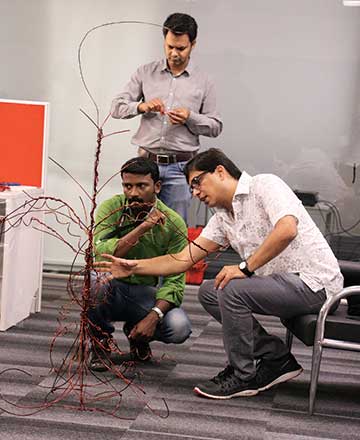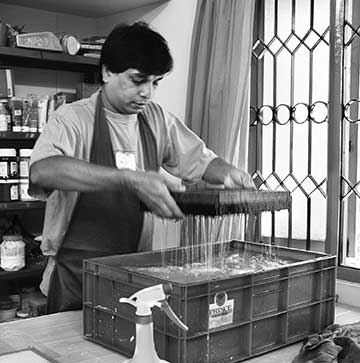Lakshmi Karunakaran
Teaching and Learning Moments is a radio show that Teacher Plus produces in collaboration with the University of Hyderabad’s community radio station, Bol Hyderabad.
Season 2 features artists who talk about the major influences of teachers/mentors in their lives and the unique perspective they bring to their students. Here we feature Sahitya Academy Award winning artist, Ravi Kumar Kashi. The article below carries excerpts from the interview. We invite readers to listen to the first of this two part interview at: http://yourlisten.com/BolHyd90.4/tlm-with-teacher-plusbol-hyderabadravikumar-kashilakshmi.
 Early childhood
Early childhood
I was born in Malleswaram in Bengaluru. Right from my childhood, I was attracted to visual art. I hung around a lot at Chitra Kala Parishad and watched others paint. In front of my school there was a sign board painter who also painted landscapes. After school I spent a lot of time just watching him.
And then there were snake charmers, all sorts of games were played on the streets. So as children we never straightaway went home after school. We spent a lot of time looking at these things, absorbing them, engaging with them. Unlike today, in those days no one monitored your time. This tremendous pressure for scoring marks was not there. You were not judged by your marks alone. I think Malleswaram and all that happened around it had a significant impact on my artistic growth. By the time I was 9 years old, I was set upon becoming an artist.
Gaps in art education
Almost all of my formal art education was based on building skills. We had four main subjects: still life study, life study, landscape study and composition. We were told that the only difference between still life and life study was that the object in still life would not shake, and the subject in life study would. Our teachers were not able to give us any insight beyond this. Even while sketching life study, we were not able to relate to our subjects as an individual human being – we were only taught to observe proportions, the tone and texture of skin, the light and the shadow etc. We didn’t realise that in that process we were in fact highly objectifying our subject. It took me many years to break out of this conditioning, and transgress these boundaries.
 Becoming a teacher
Becoming a teacher
I started to teach when I was still studying. I would go to houses and teach children to draw and paint. But it was in 1994 that I joined R V College’s Architecture Department. But I didn’t want to retire as a lecturer. I was interested in giving time to my own projects. I resigned in three years, travelled and was involved in my own work. In 2011, I rejoined and began to teach again.
But my colleagues see a huge difference in my first phase of teaching and my second stint. For a teacher, especially an art educator, it’s important to have your own practice and keep growing at an individual level. A teacher should always remain a student and retain the humility to learn.
Can creativity be taught?
Creativity was never taught in art schools. So we started to offer an elective course called ‘Visual thinking and Creativity’. It was not graded, and I started to do small experiments with the students. That helped me a lot to understand the process of creativity. Students were also very open to trying new things.
Slowly, I started to see these exercises as seeds, that sometimes students make meaning out of many years later. Usually while doing the exercise, the students are unable to grasp the gravity of the art activity. But when the time is ripe, like a zip file, it opens up. I cannot teach creativity, but I think I can help sow these seeds.
The author is an educator based in Bengaluru. She can be reached at lakshmikarunakaran@gmail.com.
